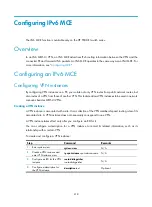
425
Step Command
Remarks
1.
Enter system view.
system-view
N/A
2.
Configure an IPv6 static
route for an IPv6 VPN
instance.
•
ipv6 route-static
ipv6-address prefix-length
{
interface-type
interface-number
[
next-hop-address
] |
next-hop-address
|
vpn-instance
d-vpn-instance-name
nexthop-address
} [
preference
preference-value
]
•
ipv6 route-static
vpn-instance
s-vpn-instance-name
&<1-6>
ipv6-address
prefix-length
{
interface-type interface-number
[
next-hop-address
] |
nexthop-address
[
public
] |
vpn-instance
d-vpn-instance-name
nexthop-address
} [
preference
preference-value
]
User either
command.
Configuring RIPng between IPv6 MCE and PE
Step Command
Remarks
1.
Enter system view.
system-view
N/A
2.
Create a RIPng process for an
IPv6 VPN instance and enter
RIPng view.
ripng
[
process-id
]
vpn-instance
vpn-instance-name
N/A
3.
Redistribute the VPN routes.
import-route
protocol
[
process-id
]
[
allow-ibgp
] [
cost
cost
|
route-policy
route-policy-name
] *
By default, no route of any other
routing protocol is redistributed
into RIPng.
4.
Configure the default cost
value for the redistributed
routes.
default cost
value
Optional.
0 by default.
5.
Return to system view.
quit
N/A
6.
Enter interface view.
interface
interface-type
interface-number
N/A
7.
Enable the RIPng process on
the interface.
ripng
process-id
enable
Disabled by default.
Configuring OSPFv3 between IPv6 MCE and PE
Step Command
Remarks
1.
Enter system view.
system-view
N/A
2.
Create an OSPFv3 process for
an IPv6 VPN instance and
enter OSPFv3 view.
ospfv3
[
process-id
]
vpn-instance
vpn-instance-name
N/A
3.
Set the router ID.
router-id
router-id
N/A
4.
Redistribute the VPN routes.
import-route
protocol
[
process-id
|
allow-ibgp
] [
cost
value
|
route-policy
route-policy-name
|
type
type
] *
By default, no route of any other
routing protocol is redistributed
into OSPFv3.






























